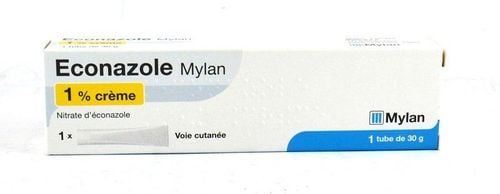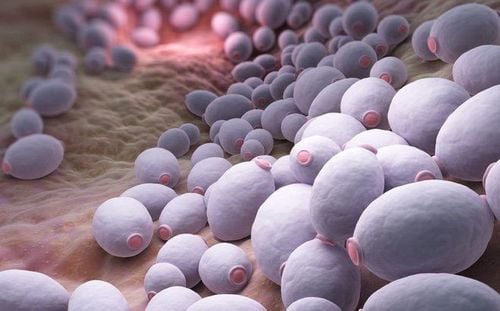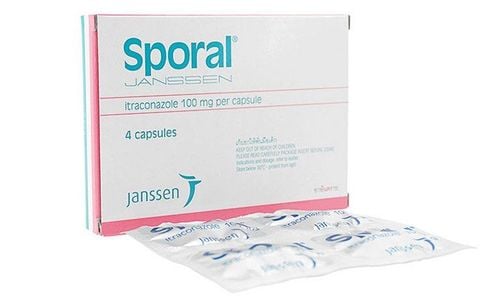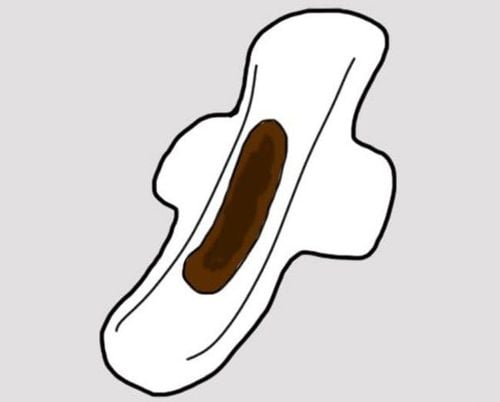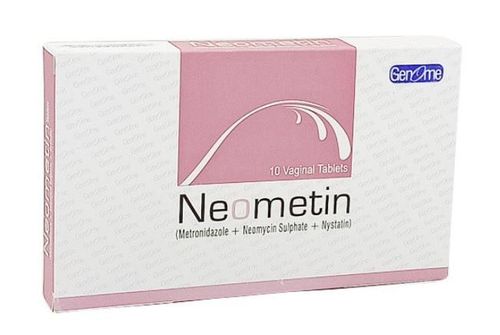This is an automatically translated article.
Ketoconazole topical is a class of antifungal drugs. The drug has a good effect in the treatment of diseases caused by fungal infections of the skin such as: fungal infections in the body (ringworm, strabismus), fungus in the hands, feet, and fungus in the groin. At the same time, Ketoconazole skin cream is also used in the treatment of skin candidiasis, ringworm and seborrheic dermatitis.
1. What is Ketovazol topical?
Ketoconazole topical is a broad-spectrum antifungal agent that is active against many pathogenic fungi. In which, fungi can be mentioned on the skin surface and mucous membranes and visceral fungi. In addition, Ketoconazole topical cream is also effective against some gram-positive bacteria.
1.1. Pharmacokinetics of Ketoconazole Topical Ketoconazole is a synthetic dioxolane imidazole derivative with fungicidal or growth inhibitory activity against ringworm yeasts (such as Candida, pityrosporum, Torulopsis, Cryptococcus). , fungi and eumycetes.
Ketoconazole is less sensitive to fungal strains such as Aspergillus, Sporothrix schenckii, some Dematiaceae, strains of Mucor and other phycomycetes with the exception of Entomophthorales. Ketoconazole has the ability to inhibit ergosterol biosynthesis in fungi and change other lipid components in fungal cell membranes. To date, no development of drug resistance has been observed during treatment with Ketoconazole.
1.2. Ketoconazole Pharmacokinetics Absorption: The mean time to peak plasma concentrations of approximately 3.5 mcg/mL is within 1-2 hours after a 200 mg oral dose. The plasma elimination is then biphasic with a half-life of approximately 2 time points during the first 10 hours and the following 8 hours. After absorption from the gastrointestinal tract, Ketoconazole is converted to several inactive metabolites. Distribution: In vitro, plasma protein binding is approximately 99%, mainly albumin. Only a negligible proportion of Ketoconazole can enter the cerebrospinal fluid. Ketoconazole is a weakly alkaline drug and as such requires an acidic environment for drug dissolution and absorption. Metabolism: The major known route of metabolism of the drug is through oxidative degradation of the imidazole and piperazine rings, oxidative alkyl reduction and aromatic ring hydroxylation. Elimination: Approximately 13% of the dose will be excreted in the urine, of which 2-4% is unchanged. The main route of excretion is through the biliary tract into the gastrointestinal tract.
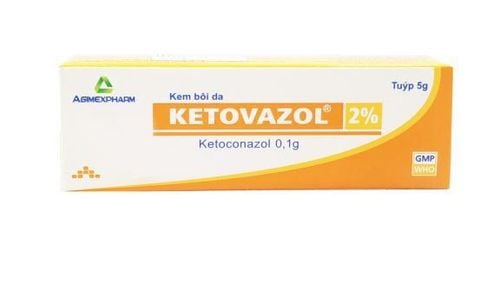
Ketovazol được dùng trong điều trị nhiễm vi nấm ngoài da
2. Effect of Ketovazol skin cream
Mechanism of action: Ketoconazole topical and azole antifungals both inhibit alpha demethylase. This is an enzyme involved in the synthesis of ergosterol). Therefore, Ketoconazole inhibits the synthesis of ergosterol and lipids of fungal cell membranes. The result is altered cell membrane permeability, inhibition of membrane function, and inhibition of fungal growth. A low dose of the drug inhibits the growth of the fungus, while a high dose of the drug kills the fungus.
Ketoconazole is indicated for the treatment of the following conditions:
Fungal infections of the skin, hair and nails caused by ringworm and/or yeast (such as ringworm, onychomycosis, periungual candidiasis, ringworm) tinea versicolor, tinea capitis, Pityrosporum folliculitis, chronic skin and mucosal candidiasis) that cannot be treated locally because of the location or spread of the lesion. injury, or due to a deep fungal infection of the skin, or unresponsive to topical treatment. Yeast infection in the gastrointestinal tract. Recurrent or chronic vaginal candidiasis that has not responded to topical treatments. Visceral fungal infections such as visceral candidiasis, fungal infections such as Paracoccidioides, Histoplasma, Coccidioides, Blastomyces. When taken orally, Ketoconazole is effective in the prophylaxis of individuals with reduced resistance mechanisms (genetic, pathological, or drug-induced) with an increased risk of these drugs. fungal infection. The drug cannot penetrate the central nervous system, so it is not recommended to treat fungal meningitis with oral ketoconazole.
3. Undesirable effects of topical Ketovazol
The most commonly reported adverse reactions associated with the use of Ketoconazole are gastrointestinal side effects: gastrointestinal disturbances, nausea, abdominal pain and diarrhea. Less commonly reported adverse reactions include headache, reversible elevations of liver enzymes, menstrual disturbances, dizziness, photophobia and other allergic reactions. The adverse events reported with low frequency were thrombocytopenia, baldness (alopecia), impotence, and reversible increase in intracranial pressure (eg, papilledema, bulging fontanelle in infants). In very rare cases, at doses higher than the therapeutic doses of 200 mg and 400 mg per day, reversible gynecomastia and low spermatogenesis may occur. At a therapeutic dose of 200 mg/day, a transient reduction in plasma testosterone concentrations was observed. Testosterone levels return to normal within 24 hours of treatment with Ketoconazole. During the period of taking Ketoconazole, hepatitis (mostly due to allergies) may occur. This condition is usually reversible if the medication is stopped immediately.
4. Dosage and how to use Ketovazol topical
Use Ketovazol topical cream on infected skin & surrounding skin, 1-2 times a day.
Treatment time is about 2-4 weeks, severe cases can be up to 6 weeks. Treatment of the disease should continue for a sufficient period of time, for at least a few days after all signs of the disease have disappeared. General physical hygiene measures should be taken to check for sources of contamination or reinfection.
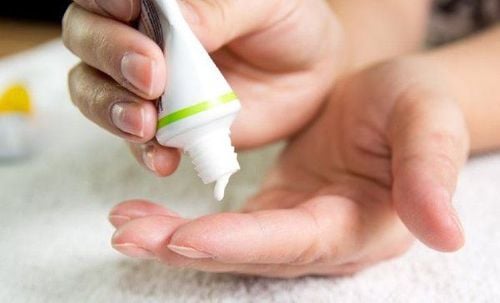
Người bệnh nên bôi thuốc Ketovazol theo chỉ dẫn của bác sĩ
5. Interactions of topical Ketovazol
Ketovazol topical may change the way other medicines you are taking work or increase the effects of possible unwanted effects. To minimize drug interactions, it's best to write down a list of all the medications you're taking (including prescription, nonprescription, herbal, and dietary supplements) and see treating doctor or pharmacist. To ensure safety when using Ketovazol topical, you do not arbitrarily use the drug, stop using or change the dosage of the drug without the consent of the treating doctor.
6. Notes when using Ketovazol topical
Ketoconazole should not be used by people with acute or chronic liver disease or those who are allergic or hypersensitive to the drug.
Contraindicated to use Ketoconazole drug with the following drugs terfenadine, pimozide, quinidine, astemizol, cisapride, triazolam, midazolam orally, HMG-CoA reductase inhibitors metabolised by CYP3A4: simvastatin, lovastatin.
For pregnant women: Ketoconazole can cross the placenta, but there are no adequate studies in humans. The drug is used during pregnancy only when the treating doctor weighs the benefits of treatment above the possible risks to the fetus.
Lactation: Ketoconazole can be excreted in milk, so mothers who are being treated with Ketovazol 2% should not breastfeed their babies.
7. How to store Ketovazol topical?
When storing medicine, you need to pay attention to some points as follows:
Keep the medicine in a dry place, the temperature is below 30 degrees C. Avoid direct exposure to light. Keep out of reach of children and household pets. Absolutely do not use Quazimin after the expiry date printed on the package. Topical drug is Ketovazol antibiotic that works to treat specific dermatological diseases, fungal diseases of the skin. To ensure effective use and avoid unwanted side effects, you should carefully read the instructions or strictly follow the instructions of the treating doctor.
Please dial HOTLINE for more information or register for an appointment HERE. Download MyVinmec app to make appointments faster and to manage your bookings easily.




